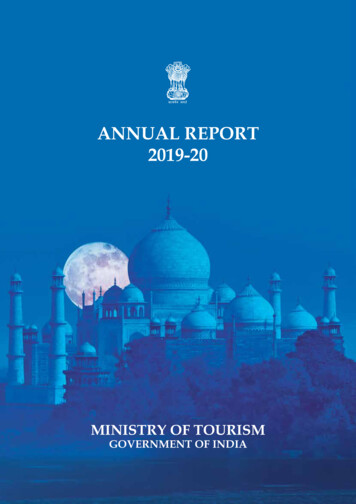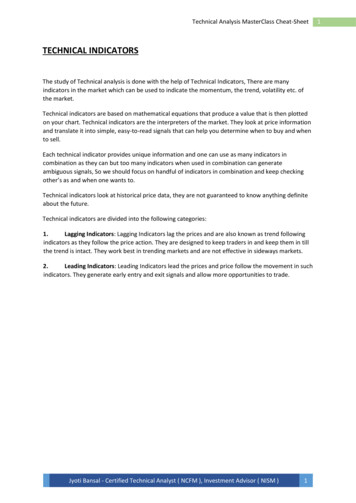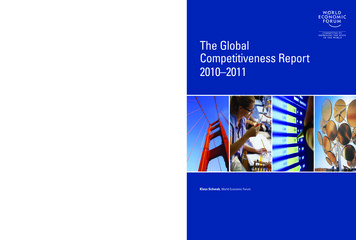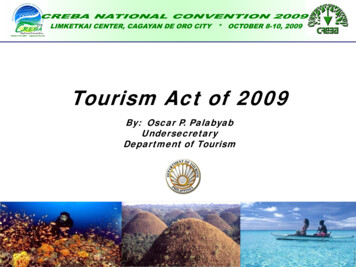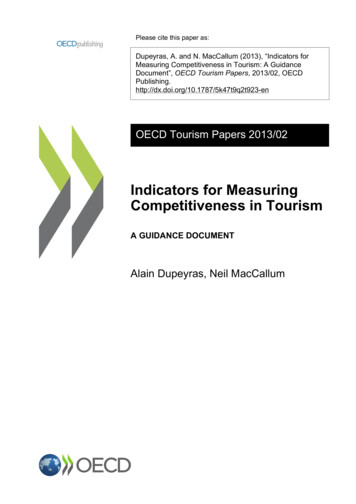
Transcription
Please cite this paper as:Dupeyras, A. and N. MacCallum (2013), “Indicators forMeasuring Competitiveness in Tourism: A GuidanceDocument”, OECD Tourism Papers, 2013/02, 923-enOECD Tourism Papers 2013/02Indicators for MeasuringCompetitiveness in TourismA GUIDANCE DOCUMENTAlain Dupeyras, Neil MacCallum
OECD TOURISM PAPERS:INDICATORS FOR MEASURING COMPETITIVENESS IN TOURISM:A GUIDANCE DOCUMENT
This work is published on the responsibility of the Secretary-General of the OECD. The opinionsexpressed and arguments employed herein do not necessarily reflect the official views of the Organisationor of the governments of its member countries.This document and any map included herein are without prejudice to the status of or sovereignty over anyterritory, to the delimitation of international frontiers and boundaries and to the name of any territory, cityor area. OECD 2013You can copy, download or print OECD content for your own use, and you can include excerpts fromOECD publications, databases and multimedia products in your own documents, presentations, blogs,websites and teaching materials, provided that suitable acknowledgment of OECD as source and copyrightowner is given. All requests for commercial use and translation rights should be submitted torights@oecd.org.
ABOUT 3ABOUT THE OECDThe OECD is a multi-disciplinary inter-governmental organisation of 34 member countrieswhich engages in its work an increasing number of non-members from all regions of the world. TheOrganisation’s core mission today is to help governments work together towards a stronger, cleaner,fairer global economy. Through its network of 250 specialised committees and working groups, theOECD provides a setting where governments compare policy experiences, seek answers to commonproblems, identify good practice, and co-ordinate domestic and international policies.The OECD member countries are: Australia, Austria, Belgium, Canada, Chile, the CzechRepublic, Denmark, Estonia, Finland, France, Germany, Greece, Hungary, Iceland, Ireland, Israel,Italy, Japan, Korea, Luxembourg, Mexico, the Netherlands, New Zealand, Norway, Poland, Portugal,the Slovak Republic, Slovenia, Spain, Sweden, Switzerland, Turkey, the United Kingdom and theUnited States. The European Commission takes part in the work of the OECD.ABOUT THE TOURISM COMMITTEEThe OECD has a long-standing expertise on tourism. Tourism is located in the OECD Centre forEntrepreneurship, SMEs and Local Development (CFE). The Tourism Committee, created in 1948,acts as the OECD forum for exchange, and for monitoring policies and structural changes affectingthe development of domestic and international tourism. It actively promotes the sustainable economicgrowth of tourism.Addressing the major challenges faced by the tourism industry, and maximising tourism's fulleconomic potential, requires an integrated and multi-faceted approach to tourism policy developmentacross many government levels and departments. In this environment, OECD members seeconsiderable benefit in co-operating to address economic, sustainability and employment issues, andpromote tourism policy performance and evaluation, innovation and liberalisation of tourism. A closerco-operation with major emerging economies is also seen as being critical to achieving a strongimpact with this work.The website of the Tourism Committee www.oecd.org/cfe/tourism provides detailed informationabout the OECD activities on Tourism.ABOUT THE PAPERMature tourism economies need to regain competitiveness as a new source of growth. Activepolicies require a good understanding of the determinants of competitiveness. This measurementframework includes a short list of core and additional indicators to guide governments in theiranalysis of tourism competitiveness and to inform tourism policy development. This framework is tobe considered by countries as a toolkit and a guide. Pilot testing of the indicators will drive the workforward. The report was reviewed and approved by the OECD Tourism Committee on 10 April 2013.OECD TOURISM PAPERS – GREEN INNOVATION IN TOURISM SERVICES - OECD
ACKNOWLEDGMENTS 4ACKNOWLEDGMENTSAlain Dupeyras, Head of Tourism, OECD, co-ordinated the project on the indicators for measuringcompetitiveness in tourism. This report has been drafted by Mr Neil MacCallum(neil4evaluation@hotmail.co.uk) and the OECD Secretariat (alain.dupeyras@oecd.org). It has benefitedfrom the inputs of numerous members and partners (e.g. case studies, comments, drafting suggestions) andfrom the support of the informal experts’ group on competitiveness issues.The work has benefited from a large and participative process. 30 member and partner countries(Australia, Austria, Belgium, Brazil, Canada, Chile, Czech republic, Denmark, Egypt, Estonia, Finland,France, Germany, Greece, Hungary, Israel, Italy, Mexico, Netherlands, New Zealand, Norway, Poland,Portugal, Romania, Slovak republic, Slovenia, Spain, Switzerland, Turkey and the United Kingdom)provided information on their work in this area. The work has also benefited from inputs from the OECDunits on Monitoring Well-Being and Progress and on Purchasing Power Parities.Two informal meetings of experts on measuring competitiveness in tourism have also been organisedto allow a detailed discussion of the issues, to more closely associate partner organisations, and to examineOECD work under development: An informal meeting of experts and country representatives held in Vienna on 27-28 June 2012was hosted by the Austrian Federal Ministry of Economy, Family and Youth and Statistics Austria.A second informal meeting of experts was held in Paris on 18 January 2013, hosted by the OECD.This meeting provided feedback and a summary of comments and suggestions from recent countryconsultations and telephone discussions on updating the framework and choice of core indicators.From this discussion, the choice of core and additional indicators was clarified.Other organisations have also participated in the development of the work and have providedfeedback, comments and inputs [UNEP, World Economic Forum, Exceltur (Spain), International Center ofStudies on the Tourist Economy (CISET), Institute for Tourism Research in Northern Europe (NIT) andChemonics].OECD TOURISM PAPERS – INDICATORS FOR MEASURING COMPETITIVENESS IN TOURISM - OECD
OVERVIEW 5TABLE OF CONTENTSOVERVIEW .6MEASURING COMPETITIVENESS IN TOURISM .10THE INDICATORS .17CORE INDICATORS .181. Tourism Direct Gross Domestic Product .182. Inbound tourism revenues per visitor by source market .203. Overnights in all types of accommodation .224. Exports of tourism services .245. Labour productivity in tourism services .266. Purchasing Power Parities (PPPs) and tourism prices .287. Country entry visa requirements .308. Natural resources and biodiversity.329. Cultural and creative resources .3410. Visitor Satisfaction.3611. National Tourism Action Plan .38SUPPLEMENTARY INDICATORS .40Market diversification and growth markets .40Employment in tourism by age, education levels and type of contracts .42Consumer price index for tourism .44Air connectivity and inter-modality .46OECD Better Life Index .48FUTURE DEVELOPMENT INDICATORS .50Government budget appropriations for tourism .50Company mortality rate .52Use of e-tourism and other innovative services .53Structure of tourism supply chains .55AREAS FOR DEVELOPMENT .56MOVING FORWARD: THE PILOT TESTING OF THE INDICATORS .59REFERENCES .60TablesTable 1.Table 2.Key elements defining competitiveness in tourism .16List of Core, Supplementary and Future Development Indicators .17BoxesBox 1. Defining competitiveness in tourism.14OECD TOURISM PAPERS – INDICATORS FOR MEASURING COMPETITIVENESS IN TOURISM - OECD
OVERVIEW 6OVERVIEWTourism is recognised as one of the key sectors of development in all countries and a major source ofincome, jobs and wealth creation. It also plays a wider role in promoting the image and internationalperception of a country externally as well as influencing complementary domestic policies. This range ofinfluence and importance creates challenges in measuring competitiveness in tourism.Understanding country competitiveness in tourism is a major consideration for policy makers and amajor challenge for professionals in providing evidence to inform decision making. Various indicatorshave been developed by different organisations over the years to address particular aspects ofcompetitiveness but there has remained a lack of an overall measurement framework for competitivenessin tourism for the use of governments. The current work by member and partner countries seeks to addressthis gap and make a positive contribution to the practical measurement of competitiveness.The influences on competitiveness can change quickly and this dynamic creates further challengesand a need for on-going research and development on indicators. Global economic and tourism trends,including changing market trends and travel behaviours, the role of social media and new sources ofdemand and growth all increase the importance of the topic and the ability of OECD and partner countriesto compete within the changing global marketplace.The OECD’s work identifies a set of indicators that can be applied within an overall framework toassess country competitiveness. The OECD approach is to create a limited set of meaningful and robustindicators useful for governments to evaluate and measure tourism competitiveness in their country overtime and to guide them in their policy choices. The aim of the framework is not to produce an index or aranking of the most competitive countries, but to provide a tool guide for countries to analyse tourismcompetitiveness and inform policy.The findings build on previous OECD work and on members and partners contributions over the pasttwo years. The work has benefited from a highly participative process with extensive country involvementthrough survey of country practices, a series of discussions at the OECD Tourism Committee meetings, aseries of follow up discussion and submissions as well as two informal meetings of practitioners. Surveyresponses and contributions were received from 30 member and partner countries (Australia, Austria,Belgium, Brazil, Canada, Chile, Czech republic, Denmark, Egypt, Estonia, Finland, France, Germany,Greece, Hungary, Israel, Italy, Mexico, Netherlands, New Zealand, Norway, Poland, Portugal, Romania,Slovak republic, Slovenia, Spain, Switzerland, Turkey and the United Kingdom) as well as contributionsfrom various organisations including UNEP, WEF, Exceltur (Spain), International Center of Studies on theTourist Economy (CISET), Institute for Tourism Research in Northern Europe (NIT), Chemonics, OECDunits on Monitoring Well-Being and Progress and on Purchasing Power Parities.There is significant interest in this work and the topic of measuring tourism competitivenessgenerally. However at industry level, there are few significant initiatives on monitoring competitiveness intourism. Evidence shows that country initiatives for developing competitiveness indicators remain ratherpartial and unequal in terms of content. This work has sought to learn from others and take forward abalanced set of indicators within a new framework for measurement based around a shared definition oftourism competitiveness.OECD TOURISM PAPERS – INDICATORS FOR MEASURING COMPETITIVENESS IN TOURISM - OECD
OVERVIEW 7The agreed definition is based upon a common understanding of the key elements definingcompetitiveness in tourism:Tourism competitiveness for a destination is about the ability of the place to optimise itsattractiveness for residents and non-residents, to deliver quality, innovative, and attractive (e.g.providing good value for money) tourism services to consumers and to gain market shares on thedomestic and global market places, while ensuring that the available resources supportingtourism are used efficiently and in a sustainable way.As a result, key indicators have been developed to address common challenges in the analysis ofcompetitiveness in tourism in member and partner countries. The indicators are organised around fourcategories: Indicators measuring the tourism performance and impacts; Indicators monitoring the ability of a destination to deliver quality and competitive tourismservices; Indicators monitoring the attractiveness of a destination; Indicators describing policy responses and economic opportunities.The measurement framework comprises three types of indicator that can be applied to measurecompetitiveness in tourism – core, supplementary and for future development. The 11 core indicators are: Tourism Direct Gross Domestic Product - a comparison of TDGDP change over years is a keystatistic of tourism competitiveness and will reinforce use of the TSA. The focus is on directimpacts, domestic and inbound tourism consumption. The challenge for the future is aboutmeasuring the indirect and induced impacts. A comparison of TDGDP change over years isperhaps the single most quotable statistic of tourism competitiveness. Inbound tourism revenues per visitor by source market - a measure of the economic activity ofvisitors identifying the percentage growth or decline year-on-year in inbound tourism revenuesper visitor by source market. The focus is on inbound tourism consumption. The challenge is dataavailability and consistent protocols. Overnights in all types of accommodation - a measure of tourism flows in accommodation,capturing the percentage growth or decline year-on-year in overnights in all types ofaccommodation or, if not available, in hotels and similar establishments. The focus is on inboundand domestic (internal) tourism economy. The challenge is measuring unregistered and privateaccommodation. Exports of tourism services - a measure of exports of tourism services and relative performancecompared with other sectors, capturing growth or decline year-on-year in value and inpercentage. The focus is on inbound tourism consumption. The challenge is to collect detaileddata for sub-segments. The measure will show change in performance reflecting competition interms of brand, value awareness and international appeal. Labour productivity in tourism services - a measure of the level and evolution of productivity ofthose employed in tourism and the productive potential of the tourism economy shown in a tableof productivity measures and growth rates by country. Productivity is a main dimension ofOECD TOURISM PAPERS – INDICATORS FOR MEASURING COMPETITIVENESS IN TOURISM - OECD
OVERVIEW 8competitiveness. The challenge relates to difficulties of measurement, particularly to addressquality issues, and the specificity of the tourism sector including the small size of businesses. Purchasing Power Parity (PPPs) and tourism prices - a measure of tourism price leveldifferences across countries expressed as indices with a basis (real or artificial) chosen by countryor country group. Changing costs are among the most important competitiveness factors. Thechallenge is to develop detailed tourism sector specific item groups and prices for individualitems. Country entry visa requirements - a measure of entry visa requirements including methods of visaissuance and of the number of visas issued per year and share of inbound tourism arrivals.Traveller mobility is a critical element and visa issues are part of the competitivenessenvironment. The challenge is to find a suitable format for policy analysis given that visa policiesvary considerably across countries. Natural resources and biodiversity - a measure of a country’s stock of natural assets, in terms ofthe number of recognised natural heritage sites and preserved areas. This should be assessedalongside with information on biodiversity and ecosystems, geographic location and populationdensity. Natural resources are key drivers of attractiveness and offer countries a competitiveadvantage. The challenge is to identify a consolidated measure. Cultural and creative resources - a composite measure of the number of recognised cultural andcreative attractions in different forms. Cultural and creative resources are key drivers ofattractiveness. Building a strategy that capitalises on cultural and creative resources can providecompetitive advantages. The challenge is to identify a consolidated measure. Visitor satisfaction - a measure of demand side attractiveness value, using a comparable measureof visitor satisfaction rating and intention for repeat visits. Visitor satisfaction is an importantqualitative indicator from the demand side. The challenge is to collect data which are based onsolid statistical methods and allow comparison over time. National Tourism Action Plan - a competitiveness eligibility indicator that recognises theexistence and quality of implementation, effectiveness and evaluation of a National TourismAction Plan to improve the competitiveness of tourism in a country. The challenge is to see howbest to capture the value of the action plan to improve the competitiveness of a destination.For each indicator, a fact sheet describes the policy context, the challenges linked to implementation,the measure and the interpretation, the data sources and methods, and the next steps.The final list of indicators has been kept short and focused in order to be practical, manageable andrelevant to immediate needs of countries. The first four core indicators aim to capture the actualperformance contribution and economic market results delivered by tourism. This can then be assessed interms of relative performance with other sectors and with other countries depending on the angle ofcompetitiveness for policy makers. The next seven core indicators measure inputs and potentialcontribution to tourism competitiveness.All the indicators complement existing sources and many that are subject to future development canbe aligned neatly with the work of partner organisations, including the OECD. Some of the indicators areready for immediate application and others will require further research and development. In addition tocovering the core indicators, countries can choose to select from the supplementary list of indicators in theOECD TOURISM PAPERS – INDICATORS FOR MEASURING COMPETITIVENESS IN TOURISM - OECD
OVERVIEW 9framework and align these with their domestic policy priorities and emphasis while also providing inputsto the all-country information set.Some indicators could change in future and the application and value of the indicators will bereviewed from evidence gathered through implementation (pilot testing). The supplementary indicators canbe developed as part of a coordinated programme of work with interested countries leading on specificindicators. In this way, progress can be made more quickly and specific country interests can be takenforward within this initiative.Member and partner countries also identified a long list of measurement aspirations, many of whichwill require further work as part of future areas for development. These were recognised and discussed atthe various meetings by members and partners but have not been resolved sufficiently to be taken forwardin this framework. These important issues (branding; weighting and use of indices; quality considerations;investment; skills; and digital capability) should be addressed as part of future work.The OECD will continue to facilitate this work and further linkages with member and partnercountries and organisations. The immediate next step is to test the core indicators and gather evidence ofpractices, methodologies and examples to refine and calibrate the framework in a way that furtherimproves the on-going measurement of tourism competitiveness.OECD TOURISM PAPERS – INDICATORS FOR MEASURING COMPETITIVENESS IN TOURISM - OECD
M E A S U R I N G C O M P E T I T I V E N E S S I N T O U R I S M 10MEASURING COMPETITIVENESS IN TOURISMOECD members have recognised the importance of competitiveness as an issue for tourism policymakers and entrepreneurs. The purpose of this work is to fill the knowledge gap and to provide asystematic framework for analysing not only the tourism competitiveness of a destination/marketplace butalso the policy responses and their ultimate impact on tourism competitiveness.The outputs should provide policy makers with the information they need on competitiveness intourism to enable the formulation of better policy responses that contribute to strengthening thecompetitive position of their economies in the global tourism market. This work provides a tool forgovernments and national agencies to assess competitiveness in tourism and to develop a set of measuresappropriate for their context. It also enables benchmarking to be developed with other countries and fostercollaborative work around an agreed set of measurements.This report capitalises on previous discussion in the Tourism Committee meetings, as well as at twoinformal meetings of experts. It proposes a set of core, supplementary and future development indicators.The core indicators provide guidance for all countries to provide measurements of tourism competitivenessindicators in a common way. Additional non-core indicators can be used to provide deeper analysis andthis may require further research and development.The focus is on the national level. Understanding the relative performance of countries in terms ofcompetitiveness and to measure it is challenging; some countries with very similar tourism systems andoffers may have considerable differences in terms of competitiveness. Developing and implementingpolicies that promote a competitive and sustainable tourism industry requires a good understanding of thedeterminants of what makes a destination competitive in tourism and appropriate information to supportpolicy analysis and monitor progress.The selection of indicators for measuring competitiveness in tourism has been made on the basis ofexisting work and practices and experience in member and partner countries. The set of indicators willserve as a start for pilot testing and further discussion and will provide a useful tool for current OECDtourism policy analysis. The pilot testing phase with countries will help to refine the indicator status andprovide examples of application and value in measuring tourism competitiveness. Members are expected tofocus first on the measurement of the core indicators. This can be done by drawing upon existing data andinformation sources as well as stimulating renewed attention to questions around the measurementprocesses. It also encourages further work to gather evidence and enable use of the additional indicators.The OECD approachThe OECD approach is to create a limited set of meaningful and robust indicators useful forgovernments to evaluate and measure tourism competitiveness in their country over time and to guide themin their policy choices.The OECD work builds on relevant outputs from the OECD (e.g. Towards Green Growth: MonitoringProgress; Framework for the Evaluation of Tourism Policies and Programmes; Compendium of OECDWell-Being Indicators), as well as on member and partner countries and industry practices in measuringcompetitiveness.The principles applied in drawing up a set of indicators are: A balanced coverage of the main elements of competitiveness in tourism with particular attentiongiven to indicators of significance for advanced economies with a mature tourism sector.OECD TOURISM PAPERS – INDICATORS FOR MEASURING COMPETITIVENESS IN TOURISM - OECD
M E A S U R I N G C O M P E T I T I V E N E S S I N T O U R I S M 11 The identification of key issues for which indicators are needed, i.e. those that are of commonrelevance to the analysis of competitiveness in tourism in member and partner countries. The use of a conceptual framework that reflects the integrated nature of competitiveness intourism while organising the indicators in a way useful to decision makers. The careful selection of indicators that best reflect major trends related to these issues. For eachindicator proposed, there is a discussion about practicalities: its policy relevance, itsmeasurability, and the data comparability.The following considerations should be kept in mind: The importance of impact, outcome and policy indicators has been emphasised repeatedly bynumerous countries and participants at each informal meeting of experts. This has informed thedevelopment of indicators. From a tourist perspective, the decision making process in making choices can be distilled downto three dimensions: from a set of options the decision maker mentally appraises the causes, theattraction (or disattraction) and the ability (or inability) of the destination to provide for them,compares and contrasts and makes a decision. These are important considerations that haveinformed our thinking on indicators and produced an integrated list of indicators that captures thedynamics of competitiveness from a tourist perspective. Tourism competitiveness indicators can look to the past, present or future. Tourism policymakers ability to maintain or improve their country’s competitiveness in the future requiresforesight on the decision making processes of the future, which may bear little resemblance todecision making processes of the past. The indicators will assist countries to gather suchevidence. In addition to this predictive aspect, the priority for policy makers is to look for evidence thattheir current policies are working. This requires indicators that measure the effectiveness andsuccess of initiatives that have been put in place. The revised list of indicators will assistcountries to gather such evidence. For more information, see also previous work of the OECD onthe Evaluation of tourism policies and programmes.Information needs for tourism competitiveness assessmentThe OECD Tourism Committee has addressed competitiveness issues and policies in various analysesand reports (e.g. on globalisation and tourism, on global value chains and SMEs, on education and training,on innovation, on policy reviews and on evaluation of policies and programmes). OECD work hashighlighted the multi-dimensional perspective of the competitiveness challenge and has brought to theforefront the absence of a good system of indicators that governments can use for measuring success andcompetitiveness in tourism. Competitiveness in tourism is not currently measured and monitoredadequately by governments. One of the reasons for this is the difficulty in identifying a few core indicatorsto effectively measure and monitor what remains a very broad concept.For member and partner countries, a system of indicators for the analysis of tourism competitivenessshould:OECD TOURISM PA
time and to guide them in their policy choices. The aim of the framework is not to produce an index or a ranking of the most competitive countries, but to provide a tool guide for countries to analyse tourism competitiveness and inform policy. The findings build on previous OECD work and on


